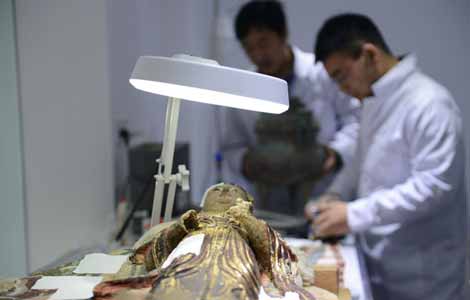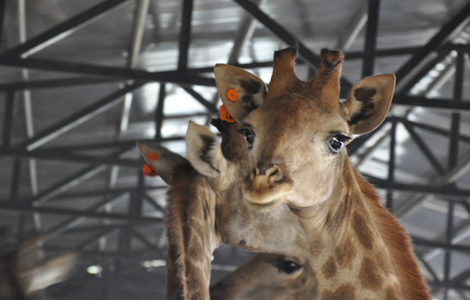

The Chang'e-3 lunar probe comprises a lander and a moon rover. The rover was named Yutu, "Jade Rabbit", via an online poll. In ancient folklore, Chang'e was a moon goddess who swallowed immortality pills and then flew from the earth to the moon. Yutu was a pet rabbit that kept the goddess company in her cold, lonely lunar palace.
The rover will explore the moon's geological structure and surface resources, creating a space engineering system for lunar patrols. It will send back 3-D images, measure infrared spectrums and analyze the lunar soil.
The difficulties facing Chang'e-3 include performing the first-ever lunar soft landing by a Chinese craft and carring out scientific research under extreme conditions, experts said.
"This mission involves a soft landing, but because the environment is an absolute vacuum, it's impossible to use a parachute," said Ouyang Ziyuan, chief scientist for the lunar orbiter project.
The only option was to install thrusters in the base of the landing gear to reduce the landing speed, he added.
Powered by solar energy, the two-winged Yutu is a 140-kilogram, box-shaped, gold-colored, six-wheeled vehicle, according to the official website of the Ministry of Industry and Information Technology.
The lander will first slowly approach its target, the Sinus Iridum, or Bay of Rainbows, a plain of basaltic lava chosen because its level terrain should help to maintain communications. When the craft reaches an altitude of 100 meters, several cameras on the bottom of the lander will photograph the terrain and relay the information to scientists on earth, said Ouyang.
If the terrain proves to be unsuitable for landing, the lander will scout the area until it finds a suitable location. The engine will be shut down when the lander is 4 meters above the lunar surface and the craft will embark on a freefall descent.
Upon landing, the legs of the lander will be buried in the lunar surface and the wings will be extended. Then, all the equipment on board will be activated and calibrated in preparation for Yutu to disengage.
Jia Yang, deputy chief designer, said the research and development of the craft took approximately 10 years.
As a completely new piece of equipment, the rover uses the same principle as the human eye to capture optical information and form 3-D images. However, unlike similar equipment where every move is predetermined, Yutu will take account of its environment while calculating its next step.
"It's mission will only last three 'moon' days, although that's equivalent to three months on earth," said Jia, referring to the moon's slow rotation, which means each "moon day" actually lasts approximately 28 days on earth.
Nuclear power will be used during the night to maintain the rover's temperature within a set, correct range, said Zhang Yuhua, deputy commander in chief and deputy chief designer of the rover system.
Because of the huge variations of temperature on the moon, from highs of 150 C during the day to lows of -180 C at night, the rover needs to maintain a constant internal operating temperature ranging from -20 to 50 C, according to a report on the Internet news portal People.
During the mission, Yutu will perform a number of major tasks. It will observe the universe and the earth from the perspective of the moon, and also assess the composition of the lunar surface, according to Ouyang.
To do that, probes will be inserted in the moon's crust to detect the geological structure 30 meters below the surface. The rover will also attempt to provide the first basic analysis of the subsurface structure to a depth of around 100 meters.







